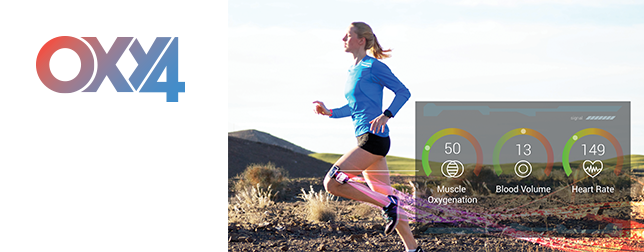In most of our daily activities the energy for muscle work mainly comes from oxidation of glucose and lipids in muscle fibers. Optoelectronic devices driven by Near-Infrared Spectroscopy (NIRS) can play a substantial role in visualizing oxidative metabolism in muscles during rest and exercise: Continuously emitted light of discrete wavelengths between 500 (visible) and 900 nm (near-infrared) penetrates the subcutaneous tissue, underlying vascular beds and muscle fibers. On its way, the light gets partially absorbed and scattered back to a detector. The main signals are the results of the O2 saturations of hemoglobin (Hb) in the vascular bed (small vessels, arterioles and veins).
Special algorithms can derive THI (Tissue Hemoglobin Index) and SmO2 (Muscle Oxygen Saturation) from the absorbance of the light data signals. THI is a trend parameter that highly correlates with the total blood volume. SmO2 (not to be mixed up with SpO2 which is the oxygenation level of the main arterial blood) is the fraction of oxygenated Hb in total Hb within the muscle tissue.
Indication of NIRS in sports science
Measurements of the parameters SmO2, THI, PR, Respiratory Rate (RR) and HRV can be obtained by the sophisticated VIS/ NIRS technology non-invasively, in real-time, wirelessly and without any limitation of the motion path either in field or laboratory environments. Moreover, this technology allows to be applied in everyday training situations yielding the possibility to display the current muscle state. In terms of performance diagnostics, VIS/NIRS systems can be used to underscore the results of lactate diagnostics and cardiopulmonary exercise tests. The area of application ranges from endurance diagnostics, rehabilitation and athletic sports to covering questions in training sciences like load tolerance and the ability to recover from a lack of oxygen. The latency of THI and SmO2 after induced load impacts is very short compared to the reaction of blood lactate levels. Early studies already showed strong correlations between lactate thresholds and decreasing saturation levels. This indication is also found for pH- and ventilatory thresholds concerning muscle oxygen saturation levels.
Current state of research and practical application
Compared to other wearable systems using continuous wave NIRS technology, the new system OXY DR1, manufactured by OXY4 GmbH/Germany, serves with several technical enhancements. The team of OXY4 GmbH invites all research institutes of sports science, sports medicine and training science to take part in the theoretical and practical development of this new technique. Starting in the first quarter of 2017, we offer you our service including the new OXY DR1 system in order to introduce you to the NIRS technology. Please contact us directly for a cooperation or visit us at MEDICA 2016 in Düsseldorf (WT Booth in Hall 15 Medica Sports Conference, CCD South).













